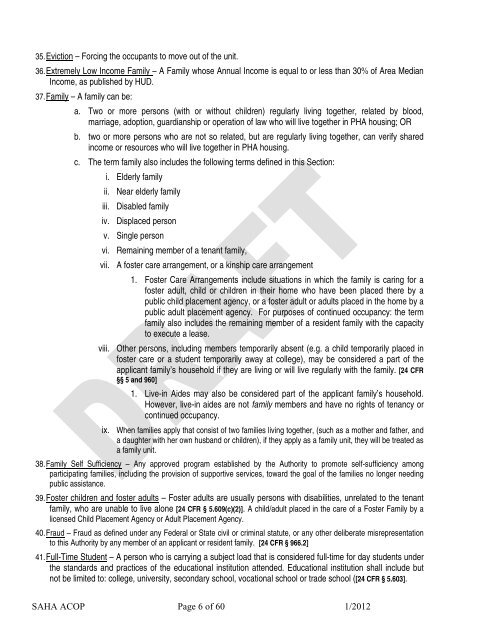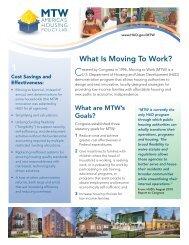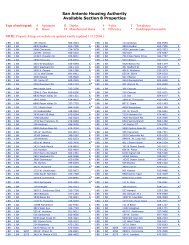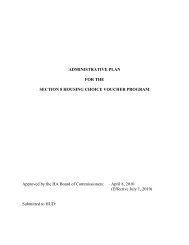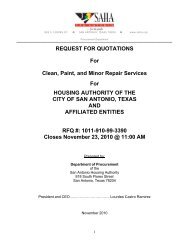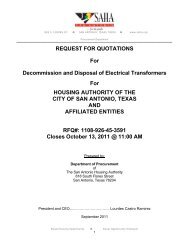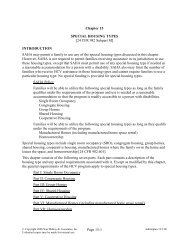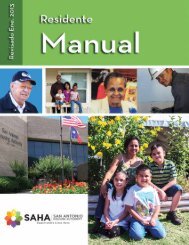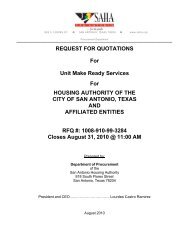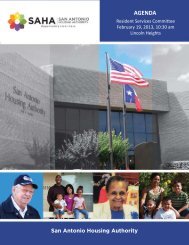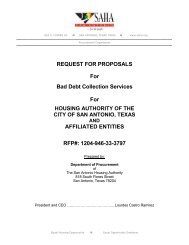You also want an ePaper? Increase the reach of your titles
YUMPU automatically turns print PDFs into web optimized ePapers that Google loves.
35. Eviction – Forcing the occupants to move out of the unit.<br />
36. Extremely Low Income Family – A Family whose Annual Income is equal to or less than 30% of Area Median<br />
Income, as published by HUD.<br />
37. Family – A family can be:<br />
a. Two or more persons (with or without children) regularly living together, related by blood,<br />
marriage, adoption, guardianship or operation of law who will live together in PHA housing; OR<br />
b. two or more persons who are not so related, but are regularly living together, can verify shared<br />
income or resources who will live together in PHA housing.<br />
c. The term family also includes the following terms defined in this Section:<br />
i. Elderly family<br />
ii. Near elderly family<br />
iii. Disabled family<br />
iv. Displaced person<br />
v. Single person<br />
vi. Remaining member of a tenant family,<br />
vii. A foster care arrangement, or a kinship care arrangement<br />
1. Foster Care Arrangements include situations in which the family is caring for a<br />
foster adult, child or children in their home who have been placed there by a<br />
public child placement agency, or a foster adult or adults placed in the home by a<br />
public adult placement agency. For purposes of continued occupancy: the term<br />
family also includes the remaining member of a resident family with the capacity<br />
to execute a lease.<br />
viii. Other persons, including members temporarily absent (e.g. a child temporarily placed in<br />
foster care or a student temporarily away at college), may be considered a part of the<br />
applicant family’s household if they are living or will live regularly with the family. [24 CFR<br />
§§ 5 and 960]<br />
1. Live-in Aides may also be considered part of the applicant family’s household.<br />
However, live-in aides are not family members and have no rights of tenancy or<br />
continued occupancy.<br />
ix. When families apply that consist of two families living together, (such as a mother and father, and<br />
a daughter with her own husband or children), if they apply as a family unit, they will be treated as<br />
a family unit.<br />
38. Family Self Sufficiency – Any approved program established by the <strong>Authority</strong> to promote self-sufficiency among<br />
participating families, including the provision of supportive services, toward the goal of the families no longer needing<br />
public assistance.<br />
39. Foster children and foster adults – Foster adults are usually persons with disabilities, unrelated to the tenant<br />
family, who are unable to live alone [24 CFR § 5.609(c)(2)]. A child/adult placed in the care of a Foster Family by a<br />
licensed Child Placement Agency or Adult Placement Agency.<br />
40. Fraud – Fraud as defined under any Federal or State civil or criminal statute, or any other deliberate misrepresentation<br />
to this <strong>Authority</strong> by any member of an applicant or resident family. [24 CFR § 966.2]<br />
41. Full-Time Student – A person who is carrying a subject load that is considered full-time for day students under<br />
the standards and practices of the educational institution attended. Educational institution shall include but<br />
not be limited to: college, university, secondary school, vocational school or trade school ([24 CFR § 5.603].<br />
SAHA <strong>ACOP</strong> Page 6 of 60 1/2012


